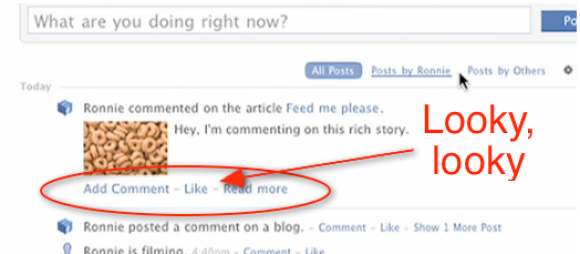 A sharp-eyed reader of the blog AllFacebook noticed something very interesting in a video that Facebook recently published — a “Like” link underneath a feed item. Sound familiar? It probably does if you’ve ever used the social content aggregation service FriendFeed.
A sharp-eyed reader of the blog AllFacebook noticed something very interesting in a video that Facebook recently published — a “Like” link underneath a feed item. Sound familiar? It probably does if you’ve ever used the social content aggregation service FriendFeed.
This functionality doesn’t appear to be anywhere on Facebook yet, but as AllFacebook’s Nick O’Neil notes, the video in question probably showed a beta area of Facebook that the company uses internally to test features. If that’s the case, there’s no guarantee that Facebook will ever launch the “Like” link for feed items, but it makes sense that they’d be working on it. After all, as FriendFeed has taught us, a “Like” is much easier than leaving an entire comment on an item, something you can currently do on both FriendFeed and Facebook.
Including the “Like” function would be the latest in a series of moves by Facebook to encroach on FriendFeed’s territory. In April, Facebook added the option to import updates from select services into your news feed. In May, it expanded this functionality, adding many of the same services that FriendFeed allows you to import. But the most obvious encroachment came in June, when Facebook added the ability for other users to comment on feed items, one of FriendFeed’s defining characteristics.
Now we have the “Like” button showing up, and it makes a Facebook news feed item’s footer even look the same as FriendFeed’s. Facebook now has “Add Comment – Like – Read More” below items, where FriendFeed has “Comment – Like – Hide – More.” Coincidence? I think not.
AI Weekly
The must-read newsletter for AI and Big Data industry written by Khari Johnson, Kyle Wiggers, and Seth Colaner.
Included with VentureBeat Insider and VentureBeat VIP memberships.
Find me on FriendFeed here, along with fellow VentureBeatniks Eric Eldon, Dean Takahashi, Anthony Ha, Chris Morrison and Dan Kaplan.
VentureBeat's mission is to be a digital town square for technical decision-makers to gain knowledge about transformative enterprise technology and transact. Learn More
